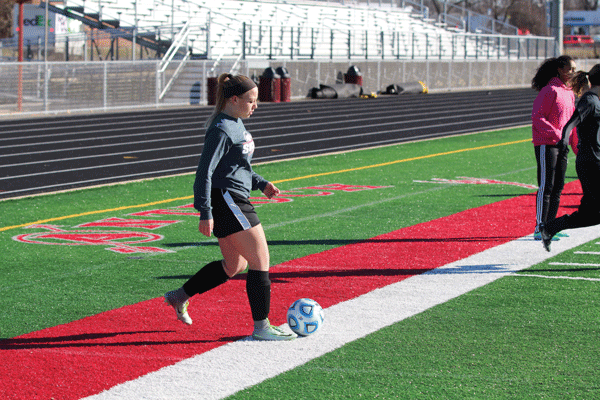Spring Fever
With the spring season kicking into action, athletes can’t wait to get outside for practices and games.

Junior Karly Monaco practices with her teammates on a cold, windy day to begin the season. The whole team is excited for this season, and the rest of the student body is excited to see how the girls’ season will conclude.
Due to the fluctuation in weather these past couple of months spring coaches are eager to get out on the field as soon as possible. Being able to get outside earlier would allow athletes to get an actual feel for how the weather factors into the games.
“It’s tough to simulate a full baseball field in the gym, especially without any dirt or grass to see how the ball will bounce off the actual ground versus a wooden gym floor,” sophomore baseball coach and physical education teacher Robert Hafer said. “Depending upon how frozen the ground is, we will hopefully be able to get out soon onto the actual ground. Getting out early would give us an enormous advantage, similar to teams that have a turf field who are able to get out as soon as the snow melts, we would then be able to do the same, granted the ground is not frozen.”
Soccer, however, has an easier time transitioning from indoor to outdoor season. Varsity soccer coach Matthew Bohmann compares practicing indoor to outdoor and the transition between the two.
“Allowing us to be outside early definitely gives us an advantage, except for when it’s windy,” Bohmann said. “Usually when it’s cold out early in the season, the girls are more focused on keeping themselves warm than [on] practice. But as soon as it’s nice out, they focus more. When we’re inside, we can basically do the same things we can outside, minus the field. We can run through the halls inside or go on the treadmills to get our cardio in.”
Both of these sports have a different view on trying their best to make do with the situation that is the weather. Spring sports have something that no other sport has to deal with: the cold start with a warm finish.
Most spring sports start with practicing indoors, doing the best they can to simulate the closest thing to playing outside. Varsity track and field coach Christopher Bailey allows his distance runners to be outside as long as they can tolerate the weather.
“The thing is to get out and train,” Bailey said. “This year we’ve been able to get outside more than usual. Distance runners haven’t even skipped a day of being outside running this year yet. When the weather was bad in past years for the distance runners, we just had them run inside, up and down stairs and lifting.”
Field events, however, are a different story. The majority of them, excluding high jump, can do virtually nothing indoors without a pit to be jumping in, gravel to be throwing on or high enough ceilings to pole vault.
“For field events, I know coach Pechauer keeps the throwers in for longer in the winter anyway, but we are able to get them out in the throwing pits earlier this year,” Bailey said. “It is hard to haul the mats back and forth, so we wait until spring break to bring them down for good. For pole vaulting, they are not able to do anything inside, which is unfortunate. There is no full approach or takeoff; they have to wait until the first indoor meet to practice.”
Sprinters have a different indoor experience. They are able to more successfully utilize the space available indoors.
“Sprinters have access to the gyms, and we have a new program where we roll out the runways to get a more accurate time and the kids get to compete and try to beat their time from the previous weeks,” Bailey said.
Whatever the spring sport, the athletes are trained to adapt to the weather as soon as they are able to get outside and get a feel for how the season will go. Until then, they are forced to be at the will of none other than Mother Nature for when they will be able to return to the fields and start competing.

